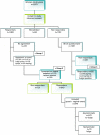The prevalence of pelvic organ prolapse symptoms and signs and their relation with bladder and bowel disorders in a general female population
- PMID: 19444368
- PMCID: PMC2721135
- DOI: 10.1007/s00192-009-0902-1
The prevalence of pelvic organ prolapse symptoms and signs and their relation with bladder and bowel disorders in a general female population
Abstract
Introduction and hypothesis: In selected populations, pelvic organ prolapse (POP) was associated with bladder/bowel symptoms, but data on the general female population are lacking. Our aim was to obtain normative data on the prevalence of POP and pelvic floor dysfunction (PFD) symptoms and signs and to identify associations.
Methods: Validated questionnaires on POP and PFD (urogenital distress inventory, (UDI) and defaecation distress inventory (DDI)) were sent to a general population of 2,979 women (aged 45-85 years). Data were analysed using the Kruskal-Wallis test, chi square test and Spearman's rank correlation coefficient.
Results: Response rate was 62.7%. Associations between POP stage and parity (0.002) and vaginal bulging (<0.001) are significant. Anatomical locations of POP and PFD symptoms correlated significantly with incontinence of flatus, feeling anal prolapse, manual evacuation of stool, vaginal bulging, constipation and pain during faecal urge (p < or = 0.005).
Conclusions: Strategies should be developed to alleviate obstructive bowel disorders associated with POP.
References
-
- {'text': '', 'ref_index': 1, 'ids': [{'type': 'DOI', 'value': '10.1111/j.1464-410X.2003.04609.x', 'is_inner': False, 'url': 'https://doi.org/10.1111/j.1464-410x.2003.04609.x'}, {'type': 'PubMed', 'value': '14764130', 'is_inner': True, 'url': 'https://pubmed.ncbi.nlm.nih.gov/14764130/'}]}
- Hunskaar S, Lose G, Sykes D, Voss S (2004) The prevalence of urinary incontinence in women in four European countries. BJU Int 93:324–330 - PubMed
-
- {'text': '', 'ref_index': 1, 'ids': [{'type': 'DOI', 'value': '10.1007/s00192-005-1351-0', 'is_inner': False, 'url': 'https://doi.org/10.1007/s00192-005-1351-0'}, {'type': 'PubMed', 'value': '16077997', 'is_inner': True, 'url': 'https://pubmed.ncbi.nlm.nih.gov/16077997/'}]}
- Van Brummen HJ, Bruinse HW, Van De Pol G, Heintz AP, Van Der Vaart CH (2006) Defecatory symptoms during and after the first pregnancy: prevalences and associated factors. Int Urogynecol J Pelvic Floor Dysfunct 17:224–230 - PubMed
-
- {'text': '', 'ref_index': 1, 'ids': [{'type': 'DOI', 'value': '10.1016/j.juro.2007.05.045', 'is_inner': False, 'url': 'https://doi.org/10.1016/j.juro.2007.05.045'}, {'type': 'PubMed', 'value': '17632167', 'is_inner': True, 'url': 'https://pubmed.ncbi.nlm.nih.gov/17632167/'}]}
- Richter HE, Nygaard I, Burgio KL, Handa VL, Fitzgerald MP, Wren P et al (2007) Lower urinary tract symptoms, quality of life and pelvic organ prolapse: irritative bladder and obstructive voiding symptoms in women planning to undergo abdominal sacrocolpopexy for advanced pelvic organ prolapse. J Urol 178:965–969 discussion 969 - PubMed
-
- {'text': '', 'ref_index': 1, 'ids': [{'type': 'DOI', 'value': '10.1067/mob.2002.123405', 'is_inner': False, 'url': 'https://doi.org/10.1067/mob.2002.123405'}, {'type': 'PubMed', 'value': '12015497', 'is_inner': True, 'url': 'https://pubmed.ncbi.nlm.nih.gov/12015497/'}]}
- Klingele CJ, Carley ME, Hill RF (2002) Patient characteristics that are associated with urodynamically diagnosed detrusor instability and genuine stress incontinence. Am J Obstet Gynecol 186:866–868 - PubMed
-
- {'text': '', 'ref_index': 1, 'ids': [{'type': 'DOI', 'value': '10.1016/j.bpobgyn.2005.08.007', 'is_inner': False, 'url': 'https://doi.org/10.1016/j.bpobgyn.2005.08.007'}, {'type': 'PubMed', 'value': '16185930', 'is_inner': True, 'url': 'https://pubmed.ncbi.nlm.nih.gov/16185930/'}]}
- Mouritsen L (2005) Classification and evaluation of prolapse. Best Pract Res Clin Obstet Gynaecol 19:895–911 - PubMed
Publication types
MeSH terms
LinkOut - more resources
Full Text Sources
Medical

